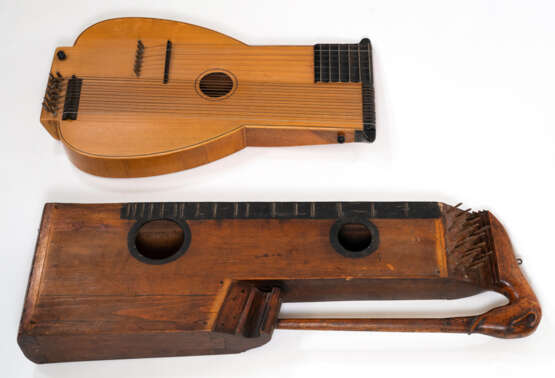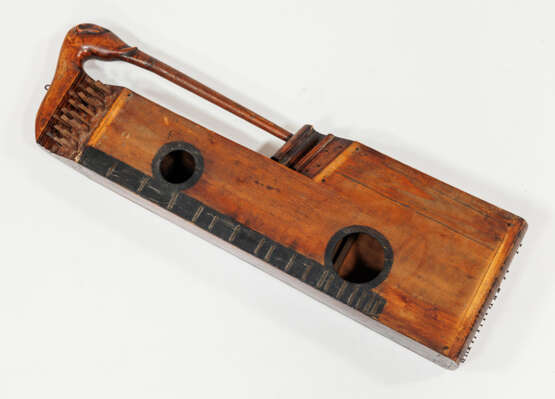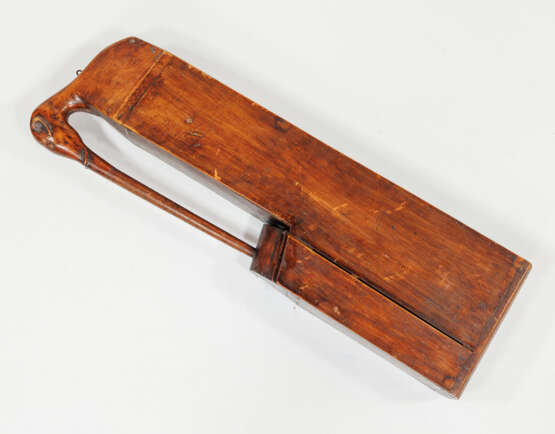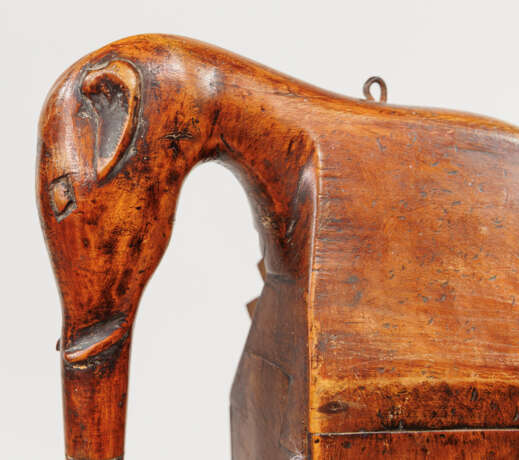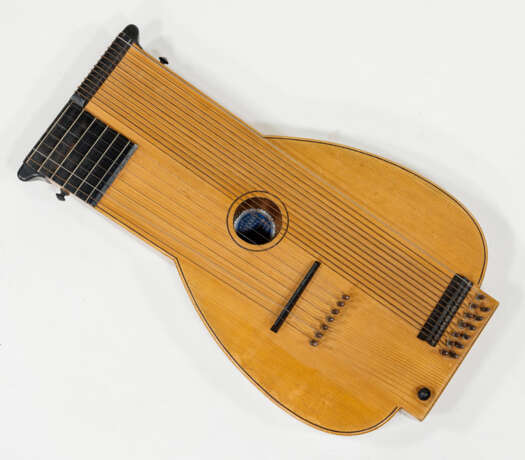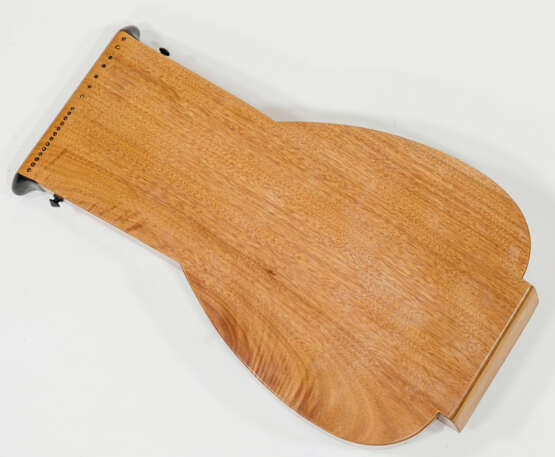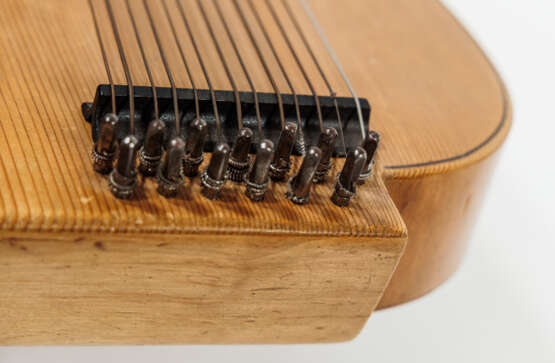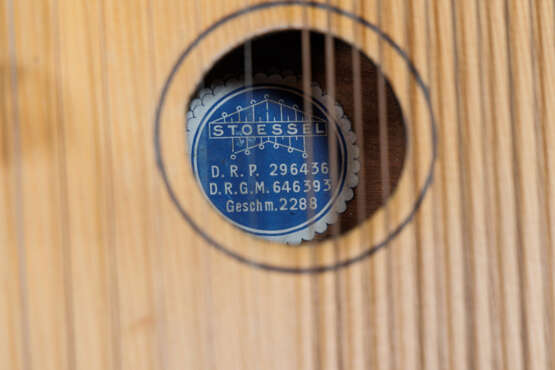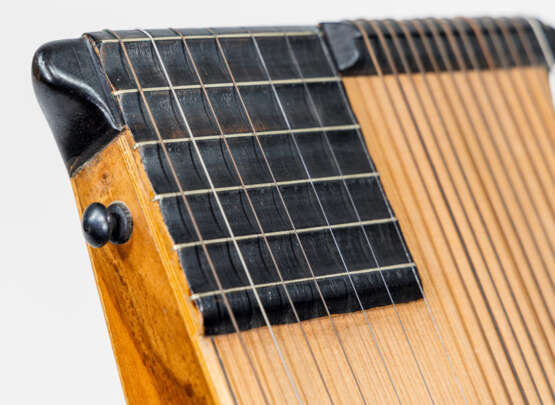ID 909770
Lot 23 | KONVOLUT HARFENZITHER UND STÖSSEL-BASSLAUTE, 20. JH.
Estimate value
€ 40 – 80
Konvolut bestehend aus bauchiger Zither/Harfenzither und einer Stössel-Basslaute/Stoessel’s Lauten-Mandoline abendländisch. Beide Instrumente vermutlich aus dem 20. Jh. mit diversen Alters- und Gebrauchsspuren.
BAUCHIGE ZITHER/HARFENZITHER (unten):
Die Normalzither österreichischen Typs ist stark mit der westeuropäischen Zither verwandt. Sie besitzt zwei Schalllöcher und einen „Griff“ bzw. Harfensäule (hier ein stilisierter Elefantenkopf, im Foto unten rechts). Das Griffbrett wird mit vermutl. drei Griffbrettsaiten und 20 Akkordsaiten bespannt.
Abmessungen inclusive Griff und Kopf: Länge: 71,5cm, Breite: 21,5cm, Höhe: 9,5cm.
STÖSSEL-BASSLAUTE/STOESSEL’S LAUTEN-MANDOLINE (oben):
Die Kastenzither (auch Stössel’s Akkord-Mandoline) besitzt 20 Saiten (davon 7 Griffbrett- und 13-Akkordsaiten) und trägt im Schallloch ein Etikett mit der Aufschrift „Stoessel D. R. P. 296436; D.R.G.M. 646393 Geschm.2288“. Es finden sich drei Knöpfe zur Befestigung eines Tragegurtes.
Die Stössel Laute bzw. Stössel-Mandoline (auch Stoessel’s Lauten-Mandoline) ist benannt nach dem Kölner Geigenbauer Georg Stössel (1867–1943). Nach Rolf Irle gehört das flache Zupfinstrument mit seinem lautenartigen Umriss zu den Kastenzithern. 1914 hat Georg Stössel seine erste Stössel-Laute gebaut. Eine zugehörige Stimmanweisung wird mitgeliefert.
Abmessungen: Länge: 53,2cm, Breite am Korpus: 30,5cm, Breite beim Griffbrett 18,3cm, Höhe: 7,5cm.
CONVOLUTE: HARP ZITHER AND STOESSEL'S BASSLUTE, 20TH CENTURY
Convolute consisting of a bellied zither/harp zither and a Stössel’s Basslute/Stoessel's lute-mandolin, occidental. Both instruments probably from the 20th century with various signs of age and use.
BELLIED ZITHER/HARP ZITHER (below):
The normal zither of Austrian type is related to the western European zither. It has two sound holes and a "handle" or harp column (here a stylised elephant's head, on the photo below on the right) at the upper left end. The fingerboard is probably strung with three fingerboard strings and 20 chord strings.
Dimensions including handle and head: Length: 71.5cm, width: 21.5cm, height: 9.5cm.
STÖSSEL’S-BASS LUTE/STOESSEL'S LUTE-MANDOLIN (above):
The box zither (also called Stössel's chord mandolin) has 20 strings (7 of which are fingerboard strings and 13 chord strings) and bears a paper label in the sound hole with the inscription "Stoessel D. R. P. 296436; D.R.G.M. 646393 Geschm.2288". There are three buttons for attaching a carrying strap.
The Stössel lute or Stössel mandolin (Stössel bass lute/Stoessel's lute-mandolin) is named after the Cologne luthier Georg Stössel (1867-1943). According to Rolf Irle, the flat plucked instrument with its lute-like outline belongs to the box zithers category. Georg Stössel built his first Stössel lute in 1914.
Dimensions: Length: 53.2cm, width at the body: 30.5cm, width at the fingerboard 18.3cm, height: 7.5cm.
| Auction house category: | Musical instruments and accessories |
|---|
| Auction house category: | Musical instruments and accessories |
|---|
| Address of auction |
Galerie Moenius AG Kirchstraße 1 56653 Wassenach Germany | |
|---|---|---|
| Preview |
| |
| Phone | +4915782646146 | |
| Conditions of purchase | Conditions of purchase | |
| Shipping |
Postal service Courier service pickup by yourself | |
| Payment methods |
Wire Transfer |
